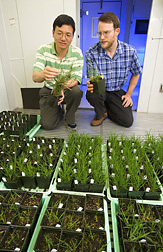This page has been archived and is being provided for reference purposes only. The page is no longer being updated, and therefore, links on the page may be invalid.
Read the magazine story to find out more. |
|
|
A Little Grass Called Brachypodium Will Be a Big Help in Biofuels Research
By Marcia WoodSeptember 15, 2008
A short little grass known as purple false brome may speed discoveries about switchgrass, its famous cousin and energy-crop hopeful.
Agricultural Research Service (ARS) scientists like John Vogel and Yong Gu at the agency's Western Regional Research Center in Albany, Calif., are probing the genetic makeup of purple false brome, or Brachypodium distachyon, as a faster way to learn more about the genes inside switchgrass.
Brachypodium (pronounced BRACKY-poe-dee-umm) accelerates energy-crop research because its genome, or genetic material, is significantly smaller than that of switchgrass, according to Vogel. The smaller genome means Brachypodium's genome can be studied in depth in a shorter amount of time than it would take to scrutinize the switchgrass genome.
The two grass species are so closely related that scientists expect findings about the Brachypodium genome to apply to switchgrass' larger one.
Vogel, a plant molecular biologist, along with research geneticist Gu and research leader Olin Anderson--all with the Genomics and Gene Discovery Research Unit at the Albany center--are the first to report the successful shuttling of new genes into Brachypodium via a bacterium widely used for this purpose in other plants. Known as "transformation," the process provides a reliable way to help uncover the function of plant genes.
In addition, Gu and colleagues have developed what's known as a "physical map" for Brachypodium--the first-ever for this plant. The map, assembled in collaboration with Ming-Cheng Luo at the University of California-Davis, and others, depicts the location of neighboring stretches of Brachypodium genes and other genetic material. Knowing where genes are located is a critical part of understanding Brachypodium's genetic makeup.
Read more about the research in the September 2008 issue of Agricultural Research magazine.
ARS is a scientific research agency of the U.S. Department of Agriculture.

